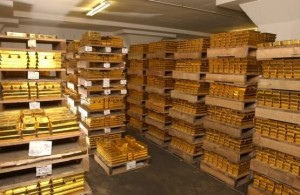by Justin Spittler, Hard Assets Alliance Analyst :
Last month, we urged readers to not lose sight of what makes gold special. Major market participants sure haven’t. In fact, Switzerland just held a public vote over whether to increase its gold holdings to 20% of total foreign reserves.
The referendum was voted down on November 30 and it wasn’t even close, which is hardly surprising considering the widespread smear campaign spearheaded by the federal government and central bank. Still, the fact that conversation reached a nationwide vote is encouraging. It’s just one of many examples of how prevailing attitudes toward gold are evolving.
Bird in Hand
Investors that look beyond the sensational headlines realize that not everyone has given up on gold. Poland, Venezuela, Ecuador, and Mexico are among the growing list of countries that have repatriated their gold reserves or have taken steps to do so. The movement has recently gained traction in crisis-stricken Europe.
Last year, Germany shocked the financial world when it requested that 300 metric tons of gold be transferred from Lower Manhattan to Frankfurt. The New York Federal Reserve offered excuse after excuse before ultimately saying the Bundesbank could have its gold back. It would just take seven years.
The Fed said it would need until 2020 to complete the delivery because they first needed to melt down gold bars. In other words, Germany’s gold was probably no longer in the Fed’s vaults. The leading theory among investment circles is Germany’s gold stash has been hypothecated, or leased out, to Wall Street banks for derivatives trading.
In any case, the Bundesbank agreed to a protracted delivery schedule. Eighteen months later, however, the Germans gave up on their repatriation efforts after receiving only 5 tons. Oddly enough, German officials maintain that country’s gold in good hands and sees “absolutely no reason” to not trust the Americans. Not every country shares this unflinching faith.
Last month, the Netherlands reported that it had transferred 122.5 metrics tons of gold from New York to Amsterdam, though it didn’t deliver the news until after the bullion had already made its way home. Dutch officials said the bullion was repatriated in order to inspire public confidence, which is interesting considering how Holland referred to its gold in Manhattan as “absolutely safe” two years ago.
France, Belgium, and most recently Austria have also conveyed interest in bringing foreign-held gold reserves home. With the global currency war heating back up and instability edging higher, precious metals investors will want to watch this trend closely.
Putting Trust to the Test
Germany’s failed attempt to repatriate 300 metric tons of gold from New York raises serious concerns over gold held outside a country’s border. In the coming years, trust between sovereign nations—even longtime allies—could be put to the test should more and more nations wish to hold their bullion within arm’s reach.
Few people monitor the actions of central banks as closely as precious metals investors. Usually, the focus is on monetary policy and gold accumulation trends, but repatriation efforts can’t be overlooked. Transporting metric tons of gold across the globe is a highly complex process. When a country makes that decision, you better believe they’ve thought about the matter long and hard.
The chorus of rational actors demanding that their gold be brought home is growing louder. Should a custodian in New York, London, or other global financial hub prove unable to return bullion to its rightful owner in a timely fashion, investors will have even more reason to mistrust the global fiat money scheme.
Article originally posted in the December issue of Smart Metals Investor at HardAssetsAlliance.com.



